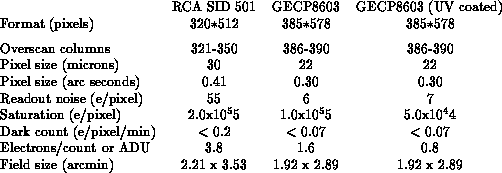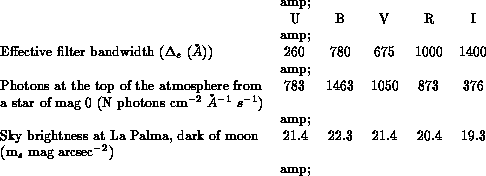




Previous: EXPOSURE TIME?
Up: EXPOSURE TIME?
Next: Time limits
Previous Page: EXPOSURE TIME?
Next Page: Time limits





Previous: EXPOSURE TIME?
Up: EXPOSURE TIME?
Next: Time limits
Previous Page: EXPOSURE TIME?
Next Page: Time limits
For stellar objects:

with 



Table 1. CCD Parameters at JKT f/15 focus


Table. ~Observational data, Kitt Peak broadband filters.
(Details of current values of readout noise, dark count and cosmic ray events can be found in the performance folder for each chip compiled by CDP and available in the control room).
CCDs are commonly used to image very faint objects. Most faint objects
beyond 20 mag are galaxies, but their extent may be similar to or smaller
than the seeing disk, so that the stellar-object s/n calculation above
still applies. Alternatively, if the extent of the object is known to be
 , the s/n can be calculated from (1) by ``modifying'' the seeing FWHM from
, the s/n can be calculated from (1) by ``modifying'' the seeing FWHM from
 to
to 
For very extended objects the s/n as a function of time is given by:



and where  is object surface brightness in magnitudes/arcsec
is object surface brightness in magnitudes/arcsec .
.
Table 1 indicates pixel sizes and readout noises, values of N, and
and
 are given for the La Palma site in Table 2, and the geometric aperture of
the JKT is 0.785
are given for the La Palma site in Table 2, and the geometric aperture of
the JKT is 0.785  .
.
Some sample sums for stellar objects are shown in Fig 6. These curves
may well provide adequate information to estimate exposure times for most
JKT CCD observations. The dramatic effect of seeing is only crudely
modelled by the approximation used in (1), which is that the usable
signal is spread into an area occupied by the half-power area of the
seeing disk. (Clever analysis might recover more signal at the higher
values of s/n, but is unlikely to do so at low s/n.) Observations cannot
be continued to infinitely faint limits. For short exposure times, s/n
 signal/readout, i.e. s/n
signal/readout, i.e. s/n  t, the noise-limited case.
But for faint objects and long exposure times,
s/n
t, the noise-limited case.
But for faint objects and long exposure times,
s/n  , i.e. s/n
, i.e. s/n  ,
the sky-limited case. The point at which the observation becomes sky-
limited, the ``knees'' in Fig 6, marks the point of diminishing returns.
,
the sky-limited case. The point at which the observation becomes sky-
limited, the ``knees'' in Fig 6, marks the point of diminishing returns.




